1. Solving Multiple Problems with Bubbles
Quite some time has passed since New Super Mario Bros. Wii came out. This time, instead of talking about all the challenging stories of development, I'd like to ask about what you have heard our customers say about it. But first I'd like you all to introduce yourselves, including what you worked on for New Super Mario Bros. Wii.
Okay. I'm the director, Asuke from the Entertainment Analysis and Development Division (EAD). This time, we wanted to make a Mario game that everyone could play together, so we aimed at a game that both people who are good at video games and people who aren't so good could play together.
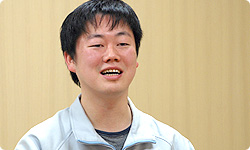
I'm Ikkaku from EAD. For New Super Mario Bros. Wii, I was in charge of stage creation - mapping and level design - and adjusting the difficulty level.
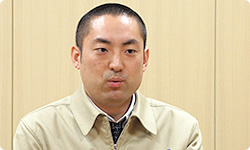
I'm Mukao from EAD. This time, I was in charge of putting together landscape and background graphics. I tried to make graphics that would make for ease in gameplay for our customers and wouldn't disappoint their expectations.
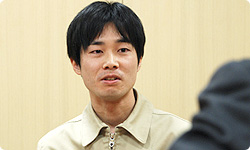
Meeting people's expectations means battling a fair amount of pressure. That's what's hard about making something with tradition.
Yes. I think lots of designers have struggled against the pressure of making something with this much tradition. We asked lots of people for advice and received lots of help.
I'm Uchida from EAD. I was in charge of sound programming and creation of sound effects. I, too, fought against a certain pressure, or the weight of tradition this time. (laughs)
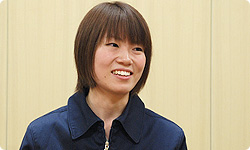
It sounds like we're going to automatically slip into talking about how challenging development was! (laughs)
Oh, sorry. (laughs)
All right, if there's anything you've heard about the game from people around you that has made an impression on you, tell me about it.
I'll start. I experienced something this time that, personally, I found quite surprising, so I'd like to tell you about it.
Go ahead.
Just into the New Year, I was riding the train, and I saw a couple of young women in maybe their early 20s talking about video games.
That in itself is quite surprising! (laughs)
Yes. Lots of people were all around, but these two women were going on quite animatedly, and as I listened, I realised they were talking about New Super Mario Bros. Wii!
Did you want to shout, "I made that game!" (laughs)
The train was packed, so I couldn't. (laughs) As I listened, it seemed that one of the two women played together with her husband on a daily basis. The other girl acted like she hardly ever played video games at all.
How did you know that?
Because the other girl said, "You've been playing video games?!"
Oh, okay. (laughs)
She hadn't played games that much in the past, but she started playing New Super Mario Bros. Wii with her younger brother after he asked her to. She said she was always holding her brother back, so her character was always in a bubble and her brother would help her forward.
That is the ideal thing to do when someone who's good and someone who isn't are playing together.
That's right. But she hated relying on her brother all the time, so she opened up a file just for herself and started playing all on her own. When I heard that, I thought she would have trouble making progress on her own, since she was someone who didn't originally play games that much, but she said she had made it up to World 3.
Wow, that's pretty good. I mean, with New Super Mario Bros. Wii, the challenging parts are pretty demanding right from World 1. I've heard a lot of people say things like, "Why so tough right at the start?!"
That's right. The challenge is the real thrill of a platform game.
But she made it to World 3.
Yes. When she heard that, the other girl who played with her husband acted surprised and said, "Wow, you're really getting good!" When I heard that, I started smiling. (laughs)
In a crowded train? (laughs) From a bystander's perspective you must have looked a little strange.
Yeah. (laughs) I did do a small "all right!"
You were so happy, you did a little fist pump in that packed train. Anyway, since it came up I'd like to ask, how did the bubble system come about?
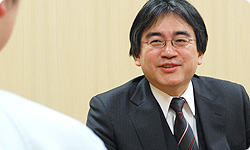
During development, when we started experimenting with four-person play, we actually played the game together that way. There were times that I messed up and fell into a hole and was the only one unable to keep playing. When that happened I thought, "Man, I wanna get back in the game!"
Everyone else was playing and having a good time, but you had messed up, so you were stuck twiddling your thumbs.
Yes. So I thought about whether there was a good way for players to get back into the game quickly. But if you mess up, you need to incur some kind of penalty, even if you return to the game right away. We thought if you reappeared in a bubble and couldn't start playing again until someone popped it, that would be a good penalty.
I see. And it would let players know, "If you get out here, you'll just mess up right away." So its importance is twofold.
Right. If someone who isn't that good at playing returns in a difficult spot, they'll just mess up again. We made it so that you're in a bubble until someone pops you out, after you've been taken to a safe place. Then later we thought of adding the ability to put yourself in a bubble anytime you want. You will suffer a penalty just like when you lose a turn, but you can have someone who is good at the game pull you forward. This was just like what Miyamoto-san is always saying about ideas.
An idea is "something which solves multiple issues at once."1 1 For "The Definition of Idea", a conversation between Mr. Iwata and copywriter Shigesato Itoi, see here.
Right. I thought that was exactly what had happened.
I do think the bubble idea was an example of very good game design.
At first, though, we weren't going to use bubbles, we were going to have people appear out of Question Blocks. (Editor's note: Question Blocks, or ? Blocks, are blocks featuring a question mark that reveal an item when Mario hits them.)
You mean, the way mushrooms pop up out of blocks, players would rise up out of them.
That's right. If you lost a turn, you would be hidden in a block. When another player hit that, you would come out of it to go back to the stage. And that was sort of fun. But as we continued making a bunch of different courses, some had lots of Question Blocks and some hardly had any. Players' desire to get back into the game as soon as possible, however, wouldn't change with the course.
Seeing yourself in a bubble and waiting for a Question Block to finally appear would feel completely different to the player who is waiting.
Yes, completely different. When you're in a bubble, everyone can see you, so you're like, "Hurry up and pop me! Help!" But if you're hidden in a Question Block somewhere, you're like, "I've got a feeling…..that I'm in that block." (laughs)
You can't be sure.
Then what if you hit it and only get a coin?
Depressing, huh? (laughs)
Yeah. Both players would be pretty bummed. (laughs)
Coming out of a Question Block might have been all right because it provides a pleasant surprise, but design-wise, having both the helper and helped get depressed isn't so great.
That's exactly right.
